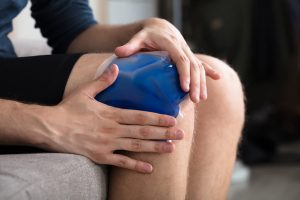Icing or Heating an Injury: Which One Do You Need

Injuries are an inevitable part of life; when they happen, it’s essential to treat them properly to promote healing and reduce pain. Two standard therapies used for injuries are icing and heating. But which one is best for your particular injury? The answer isn’t always straightforward, as each therapy has its own benefits and drawbacks depending on the type and severity of the injury. Understanding the differences between icing and heating can help you decide which therapy to use to speed up your recovery. In this article, we’ll explore the science behind icing and heating and provide some tips on choosing the right therapy for your injury.
What are the Benefits of Icing an Injury or Sore Muscle?
Icing an injury or sore muscle can provide several benefits. Here are some of the benefits to icing an injury or sore muscle:
- Reduces inflammation: Applying ice to an injured or sore area can help reduce inflammation, a common cause of pain and swelling. Ice works by constricting blood vessels in the affected area, which can help limit the amount of swelling.
- Alleviates pain: Ice can also help to relieve pain by numbing the affected area and reducing the transmission of pain signals to the brain. This can be especially helpful for acute injuries, such as sprains or strains.
- Speeds up recovery: By reducing inflammation and pain, ice can help to speed up the healing process and allow the injured area to recover more quickly. This can be especially important for athletes or others returning to normal activities immediately.
Some situations where ice might be a good choice include:
- Acute injuries, such as sprains or strains, are accompanied by swelling and inflammation.
- After engaging in physical activity or sports to reduce muscle soreness and inflammation.
- For chronic conditions, such as arthritis, to reduce pain and inflammation.
It’s important to note that ice should not be applied directly to the skin, as this can cause damage to the skin and underlying tissue. Instead, a thin towel or cloth should be used to protect the skin.
Icing an Injury: To ice, an injury, follow these steps:
- Apply the ice pack to the affected area for no more than 20 minutes at a time.
- Allow the skin to warm up for at least 40 minutes before reapplying the ice pack.
- Repeat this process every two to three hours for the first 48-72 hours after the injury.
- It’s important to wrap the ice pack in a towel or cloth to avoid direct contact with the skin, which can cause tissue damage.
What are the Benefits of Putting Heat on an Injury or Sore Muscle?
Applying heat to an injury or sore muscle can offer a range of benefits. Here are some of the benefits to using heat for an injury or sore muscle:
- Promotes blood flow: Heat increases blood flow to the affected area, which can help to promote healing by delivering oxygen and nutrients to the damaged tissue. This increased blood flow can also help to flush out waste products and reduce inflammation.
- Reduces stiffness: Heat can help to relax muscles and reduce stiffness, making it easier to move and reducing the risk of further injury. This can be especially helpful for chronic injuries or conditions like arthritis or back pain.
- Alleviates pain: Heat can effectively reduce pain by decreasing the transmission of pain signals to the brain. It can also help reduce muscle spasms and tension, contributing to pain.
- Increases range of motion: By promoting blood flow and reducing stiffness, heat can also help to increase the range of motion in the affected area.
Some situations where heat might be a good choice include:
- Chronic injuries or conditions, such as arthritis, are not accompanied by swelling or inflammation.
- Muscle strains or stiffness.
- Before engaging in physical activity or stretching, warm up the muscles and reduce the risk of injury.
It’s important to note that heat should not be used for acute injuries or injuries with swelling or inflammation, as this can exacerbate these symptoms.
Heating an Injury: To heat an injury, follow these steps:
- Apply a warm compress or heating pad to the affected area for 15-20 minutes.
- Avoid applying heat directly to the skin, and wrap the compress or pad in a towel or cloth.
- Repeat this process every two to three hours as needed.
- It’s generally recommended to apply heat to an injury a few days after it occurs, once the initial swelling and inflammation have subsided.
It’s important to note that you should never apply heat to a new injury, as this can increase swelling and inflammation.
Should I Ice or Heat My Injury Or Sore Muscle?
Choosing whether to use ice or heat for an injury or sore muscle can depend on various factors, including the type of injury, how long it’s been since the injury occurred, and the individual’s preferences. Studies have shown that using ice for acute injuries can reduce pain and swelling. Here are some general guidelines for when to use ice or heat:
When to Use Ice:
- Acute injuries, such as sprains, strains, and bruises
- Injuries that are accompanied by swelling and inflammation
- Within the first 48-72 hours after an injury occurs
- To alleviate pain and reduce swelling
- To numb the affected area and minimize nerve activity
When to Use Heat:
- Chronic injuries, such as muscle strains or stiffness
- Injuries that are not accompanied by swelling or inflammation
- After the initial 48-72 hours following an injury
- To increase blood flow and promote healing
- To alleviate stiffness and improve flexibility
Using Both Ice and Heat: In some cases, using both ice and heat can effectively manage an injury. This is often referred to as contrast therapy or hot-cold therapy. The theory behind this approach is that the alternating application of heat and cold can improve circulation and promote healing.
How Else Can I Treat a Sore Muscle or Injury?
It’s important to remember that every injury is different, and what works for one person may not work for another. If you’re unsure what to do, consulting with a professional is always best.
One option is to visit a physical therapist to assess your injury and provide a personalized treatment plan. They may use massage, stretching, or strengthening exercises to help alleviate pain and promote healing.
If your injury or soreness persists or worsens, booking an appointment with our Pro Staff Physical Therapy expert team is essential. They can help you manage your injury and ensure you’re on the right track to recovery. Contact us today!
Pro Staff Institute, LLC, has a network of outpatient physical rehabilitation centers in New Jersey. Pro Staff was founded in 2010 by Frank Pavlisko and Michael Maffucci. Through Frank’s 25 plus years experience in Physical Therapy and Michael’s experience in Management Services, our goal is to exceed customer expectations by providing the highest quality of service in a fun, family, friendly, and encouraging environment.
PRO STAFF LOCATIONS
OFFERING CERTIFIED
HAND THERAPY
Managing Diabetes: The Role of Physical Therapy
Managing Diabetes: The Role of Physical Therapy As of 2024, approximately 38.4 million Americans, or 11.6% of the U.S. population, have diabetes. Of these, 29.7 million cases are diagnosed, while an estimated 8.7 [...]
Staying Active and Injury-Free During Summer Activities
Staying Active and Injury-Free During Summer Activities Summer is a fantastic time to engage in outdoor sports and physical activities. Whether playing soccer, tennis, cycling, or jogging in the park, staying active is [...]
The Importance of Posture: How Proper Alignment Can Prevent Pain and Injury
The Importance of Posture: How Proper Alignment Can Prevent Pain and Injury In today's fast-paced world, where many hours are spent over desks, smartphones, and computers, posture is often neglected. Poor posture can [...]




